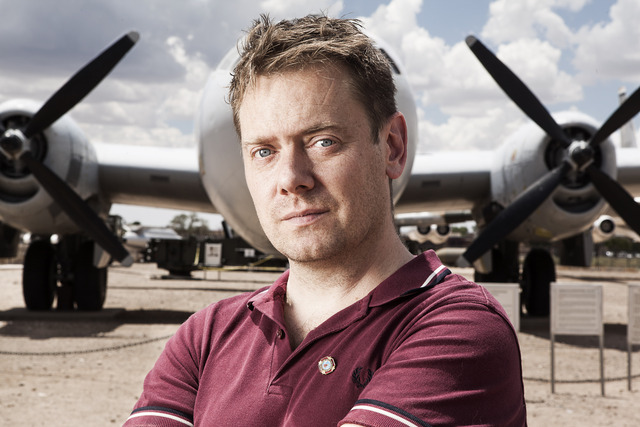As a state, New Mexico takes pride in some rather interesting things: the ability to concoct a seemingly endless array of meals with cheese, potatoes and green chile; or Albuquerque being the setting for a TV show about a cancer-addled high school chemistry teacher turned Machiavellian meth dealer. Another intriguing source of state pride is our explosive, nuclear contribution to the history of mankind and the resultant atomic tourism attractions. A prominent example of New Mexico profiting from nuclear tourism is the National Museum of Nuclear Science and History in Albuquerque (tagline: “Reactions welcome”). I spoke with James Reich, author and half of post-punk duo Venus Bogardus, at the Museum about fiction, feminism and fission. Soft Skull Press released Reich’s new novel, Bombshell, on July 16, the 68th anniversary of Trinity Nuclear detonation in the Jornada del Muerto Desert (aka White Sands). Another popular nuclear tourism site, an hour-long visit to Trinity is the equivalent of a day’s worth of regular everyday radiation exposure. Nevertheless, the site remains a popular tourist attraction for the nuclear aficionado; the (dubious) reward is apparently worth the (obvious) risk. “Someone mentioned that one of the themes they got out of the book was a derision for nuclear tourism,” Reich said. “And this [museum] is part of the nuclear tourism industry.” He visited the Museum once before the interview “just out of morbid curiosity. I found it disturbing for more reasons than I could recount.” Reich specifically found his experience of visiting Heritage Park, located behind the Museum, to be downright frightening. “It’s scary to me to stand next to an intercontinental ballistic missile,” he said. “It’s a bit much. It’s the worst kind of tourism, isn’t it?”In the midst of our tour through the museum’s “Atomic Kitsch” section, I noticed a metal lunchbox, red on one side, yellow on the other. The red side is emblazoned with the word “Biohazard” and its clawlike symbol, while the yellow side screams “Radioactive” with its familiar tripartite logo. I confess to Reich that I own this lunchbox and thus feel a little complicit in embracing this garish nuclear iconography. Reich replies that it can be hard not to be, “that it’s really seductive. These ’50s-style graphics, or industrial-style graphics, they work for a reason. They get to us, either on an aesthetic level or on some unconscious level.”Indeed, one of the major themes of the book is the idea of images and events perpetually haunting us—and, in some instances, happening again. Reich explained that a motivating factor for writing Bombshell was that he “knew the anniversary of the Chernobyl disaster was coming up, so I attempted to write a manuscript about an event that coincides with the 25th anniversary (in 2011); then, Fukushima occurred about a month before. But before anyone gets carried away with any predictive stuff, you can almost throw a dart at the calendar and hit a nuclear accident.”“One of the things about writing the book is that it brought me into contact with these incredibly bleak scenarios and histories, much of which I wasn’t aware of,” Reich continued. “And when you dig down into the instances of accidents, it becomes pretty disturbing.”Reich acknowledges that he writes “from a position of protest,” but that “the limits of protest are always shifting, as are the targets. These ideas are co-opted and absorbed with incredible efficiency by the very targets they seek to offend.”In writing Bombshell, Reich was also motivated by a desire to redefine the traditional nuclear thriller story, with its valiant CIA agents traipsing across the globe in hot pursuit of dastardly Russians hell-bent on blowing up the world. “As much as I really dislike archetypal writing—the first book that I wrote (I, Judas) was kind of an attempt to obliterate archetypes—this book in a sense abuses the archetypes that exist within the thriller,” Reich said.Bombshell’s heroine is anti-nuclear terrorist Varyushka Cash, born at the exact same moment that the Chernobyl disaster began in the Ukraine and raised on a diet of Riot Grrrl and radical feminism. The meltdown into which she was born—literally and figuratively poisonous—leads her to stage a violent cross-country takedown of the nuclear industry. “Finding myself in New Mexico, cradle of the Bomb, is a kind of necessary existential perversity,” Reich said. “I love New Mexico, but in terms of Bombshell, that violent fury that Cash brings against the nuclear industry is, in essence, my own.“The thriller genre is conventionally chauvinist,” Reich explained, “so Cash’s attachment to Valerie Solanas [radical feminist and attempted assassin of Andy Warhol] is intended to subvert that. Solanas is marginalized—within feminism, even. So, with Cash being born in what is now an exclusion zone in the former Soviet Union, she is alienated geographically, existentially and even to an extent within her mode of revolt.”Meanwhile the novel’s antagonist, CIA agent Robert Dresner, “represents the ‘worst’ of the genre,” Reich said. “It’s a critique. With my publisher, we ultimately decided to push the conventions of the thriller and see how far we could distort it, and leave it relatively recognizable.”Reich concedes that, because so many people think of the word “feminist” as a pejorative, “the fact that Bombshell says ‘feminist nuclear thriller’ on the back will make some people run away from it. I mean, I anticipate some levels of resistance. That may be a disappointment to some readers, who think it’s gonna be a straight thriller.”Still, that’s a risk that, like rebel girl Cash, Reich is willing to take. The thriller, he says, “can’t just keep being this one thing where there are certain kinds of resolutions to be expected, and it makes you feel better.”
Bombshell Reading, Signing and Q&A with author James ReichSaturday, August 10, 3 p.m.Bookworks4022 Rio Grande NWCall 344-8139 or visit www.bkwrks.comFree










